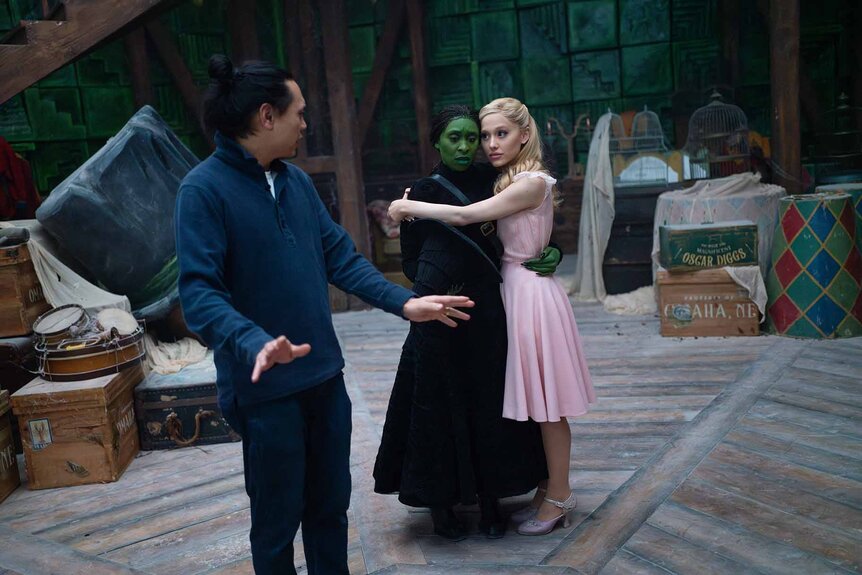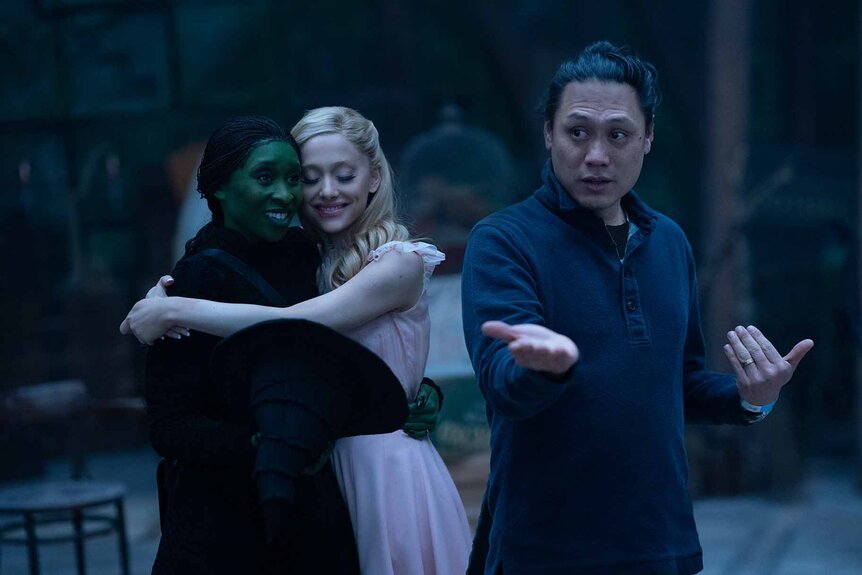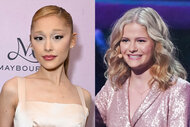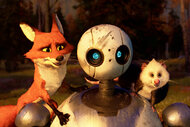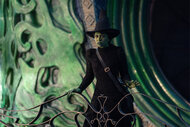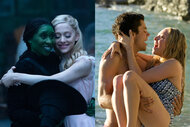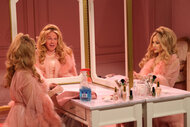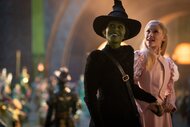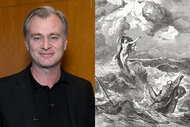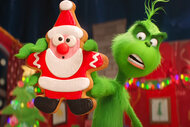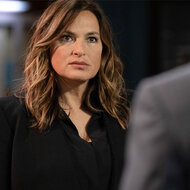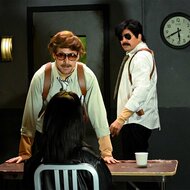Create a free profile to get unlimited access to exclusive show news, updates, and more!
Why "Defying Gravity" Was the Most Challenging Song in Wicked: "There Are No Shortcuts..."
How do you get the cleanest vocals possible for a movie musical? You hire an Academy Award-winning sound guy.
If Simon Hayes had been asked to work on director Jon M. Chu's wildly ambitious film adaptation of Wicked a decade ago, he says he may not have yet gained enough experience to deliver live vocals on this scale, despite the fact that one of his greatest ambitions for years was top help bring the acclaimed Wizard of Oz prequel to the big screen.
"It kind of feels like every single movie that I've done in my lifetime has been giving me tiny bits of aspect and information and workflow that I could put together that culminated in me being able to deliver Wicked," the Academy Award-winning production sound mixer behind such massive sonic undertakings like X-Men: First Class, Les Misérables, Guardians of the Galaxy, and No Time to Die tells NBC Insider over Zoom. "To be honest with you, I feel like this movie is my life's work."
RELATED: Wicked's Cynthia Erivo Whistles Gorgeous, Haunting Version of "Somewhere Over the Rainbow" (WATCH)
All of the solo musical performances in Wicked were recorded live on-set
The biggest and most difficult hurdle to overcome was the fact that Chu wanted to record the solo performances live on-set without need for too much post-production additions such as automated dialogue replacement (better known by film professionals as ADR). Wanting to forego ADR, especially in the context of a massive studio musical, "isn't normal," Hayes explains, though he was more than up to the challenge. "We bonded over a passion for movie musicals," the mixer says of his initial meeting with the director. "We immediately had common ground. What we both wanted to do is tell an emotional story."
But how do you get clean audio on a film set, which is full of hundreds of crew members and always buzzing with some kind of activity? It wasn't easy, particularly due to "the amount of footfall and background noise we had to cope with," states Hayes, going on to highlight the sound team's close collaboration with cinematographer Alice Brooks, production designer Nathan Crowley, and choreographer Chris Scott. "When Jon Chu says, ‘I want to go live,’ he's not just asking me, he's letting all of the artisans know. And what then happens, is everyone makes a huge, unprecedented effort; we all work together to make the movie set the quietest place possible."
In addition, the main cast members — primarily Cynthia Erivo (Elphaba), Ariana Grande (Glinda), Michelle Yeoh (Madame Morrible), Jonathan Bailey (Fiyero), Ethan Slater (Boq), Marissa Bode (Nessarose), and Jeff Goldblum (The Wizard) — needed to be fitted for custom in-ear monitors (IEMs), so they could hear a high quality version of the music they were singing to without the need for speakers. "They can have complete vocal support in the same way they would have if they were onstage at a rock concert or any kind of music event," Hayes adds. "My primary instinct is to never let the actors feel that they are technically limited in their creativity. It’s my job to make sure they don't have to worry about the technical aspect of filmmaking; that they can just immerse themselves in their characters and the creative role of acting those characters."
Pushing for live solos also allowed the actors to organically flit between dialogue and lyrics. "If we tried to do that with a pre-record, we'd get that old school, traditional musical thing where you go, ‘Oh, there's the lip sync!’" Hayes notes. "What we get from the live, is we never have that awful brick wall transition between lip sync and live dialogue. The whole thing is one emotional performance."
Of course, some pre-records were necessary for wide shots in order to avoid wearing out an actor's voice ahead of a close-up. "Being able to say things to Cynthia [like] ... 'Let's save your voice so that we know you've got full vocal strength when we arrive at the point in the filmmaking process where we're going to capture your live vocal performance,' rather than having her sing over three cameras shooting wide shots."
RELATED: Changes the Wicked Movie Made From the Original Musical, Explained
Getting the purest recordings imaginable trumped almost everything and besides, any sound equipment — be it IEMs or boom microphones — that appeared in the frame could simply be removed in post-production by Pablo Helman's visual effects team. "By prioritizing those emotional performances rather than the technical aspect of filmmaking, we've got something that jumps out the screen at us," Hayes says. "You believe what you're watching rather than having something that is formulaic."
He continues: "There's a fragility in these emotional performances that I think comes from giving these actors the freedom to sing live, to shoot rehearsals, to do close-ups before wide shots, which is the opposite of what we'd normally do. And all of this is part of the Jon Chu methodology of making a movie musical. It all starts with Jon. He's the team leader; he's the guy that says to the whole crew, ‘I want to shoot these vocals live. We’ve got to get this set quiet. We've got to do everything we can. We can't just assume that I'm going to re-record any vocals in post. I want to use these performances.’"
Why "Defying Gravity" posed the biggest sonic challenge for Wicked
The biggest technical challenge for the sound department throughout the production of Wicked Part One was the filming of Act I's showstopping musical number, "Defying Gravity," in which Elphaba brazenly defies the Wizard and secures her destiny as the Wicked Witch of the West by taking to the skies on her iconic broomstick. Hayes' goal of capturing Erivo's live performance rested on the mitigation of two external main factors: wind and wires. The first element called for the sound mixer's patented system known as "silent wind," a filmmaking innovation he and his team have been refining since Matthew Vaugh's Stardust.
"[It's] a system whereby we leave the wind machines outside the stage. We knock holes in the wall of the soundstage, and we pipe in the air," Hayes explains. "Now this seems [obvious] but 10 years ago, that just didn't happen. If there was a wind aspect on an interior soundstage, basically the sound would be ADR’d. And so what we've done, is we've developed this technique where we have jets of air, which are held by VFX crew, and they're following their actor, and that's what they were doing. They were following Cynthia's journey on multiple jets of air."
RELATED: NBC Reveals Epic, Behind-The-Scenes Wicked Special Defying Gravity: Everything to Know
As for the wires, the stunt team went out of their way to create a virtually noiseless rig — yet another example of how this movie flew (pun intended) in the face of traditional moviemaking practices:
"The question came up, ‘Well, hang on a second. Cynthia's got all of this air on her, the cape's blowing everywhere, we’re flying her, she's doing somersaults. Are you sure you're not going to pre-record?’ Jon was immediately like, ‘No, we're not pre-recording anything. Cynthia wants to sing this live and we're all here to support that.’ From that first conversation in prep, the stunt team basically raised their game and said, ‘Okay, there's bits of machinery we can put outside the stage — like the hydraulics that run the wires. That would normally be in the stage [but] we're putting it outside the stage.' It just creates more work, more planning, and a higher level of professionalism. There are no shortcuts and I think that one thing that the whole crew had in common on this was we were prepared to raise our game [in order] to give Cynthia and Ari the freedom to sing live."
Did the sound mixing process differ on Wicked Part Two?
While the decision was made to split the long-awaited translation of the Broadway musical into a pair of films, the second of which will hit theaters next November, Hayes insists the crew never saw treated the back-to-back production as a segmented animal.
"We made one enormous movie for Jon Chu," the sound mixer concludes. "We didn't treat the two parts in any different way, and it just meant there was a cohesiveness in the way we told the story from a filmmaking perspective. There were no breaks, there was no changes in crews, there was no [case of] someone leaving to do another movie and someone else stepping in. It meant that this very tight-knit team around Jon, Ari, and Cynthia had this continuity where we almost had a telepathy — like a filmmaking backhand — where we stopped needing to actually articulate things. It could be done with looks and smiles and just creating this blanket of support around these actors, so that they felt completely and utterly immersed in the world of Oz."
Wicked Part One is in theaters now. Get tickets at Fandango. Wicked Part Two hits theaters November 21, 2025.




